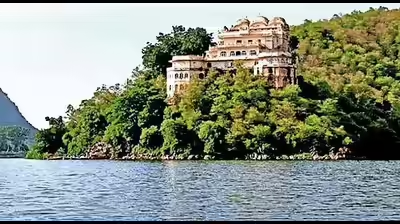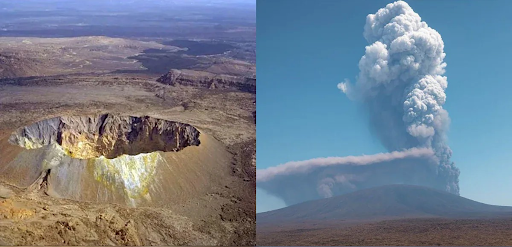




Disclaimer: Copyright infringement not intended.
|
Parameter |
Details |
|
Other Names |
Upper Vaitarna Dam, Middle Vaitarna Dam |
|
Location |
Nashik district, Maharashtra |
|
River |
Vaitarna River (a tributary of Ulhas River) |
|
Purpose |
Drinking water supply, irrigation, hydroelectric power generation |
|
Construction Year |
1950s (Upper Vaitarna), 2012 (Middle Vaitarna) |
|
Type of Dam |
Gravity & masonry dam |
|
Height |
82 meters (Middle Vaitarna Dam) |
|
Length |
2,608 meters |
|
Reservoir Capacity |
565 million cubic meters (MCM) |
|
Catchment Area |
1,282 sq. km |
|
Power Generation |
Hydroelectric power generation capacity of 60 MW |
|
Managed By |
Brihanmumbai Municipal Corporation (BMC) |
|
Significance |
One of Mumbai's primary sources of potable water |
Vaitarna Dam System consists of three major reservoirs:
|
Dam |
Purpose |
Location |
|
Upper Vaitarna Dam |
Oldest dam in system, major supplier of water to Mumbai |
Built in 1950s, on Vaitarna River |
|
Middle Vaitarna Dam |
Augments Mumbai's water supply, now a site for floating solar projects |
Constructed in 2012, Nashik |
|
Lower Vaitarna Dam |
Stores & regulates excess water |
Located downstream |
These dams collectively supply around 1,200 MLD (million liters per day) of water to Mumbai.
Water Supply Significance:
|
Aspect |
Details |
|
Primary Source of Water |
Mumbai’s municipal water supply (along with Bhatsa, Tansa Tulsi Lakes) |
|
Annual Water Yield |
~1,000 million cubic meters |
|
Catchment Rainfall |
Receives high monsoonal rainfall (2500–3000 mm annually) |
|
Water Storage & Release |
Helps regulate water flow, preventing floods & shortages |
|
Drought Resistance |
Crucial for water security in dry months |
|
Feature |
Details |
|
Project Name |
100 MW Floating Solar Photovoltaic (FSPV) Plant |
|
Developers |
ABIL & Mahalakshmi Group |
|
Announced On |
March 2024 |
|
Technology Used |
Floating Solar Panels on Reservoir Surface |
|
Benefits |
Optimizes land use by using water surface |
|
Challenges |
Mooring & anchoring difficulties in fluctuating water levels |
|
Positive Impact |
Concerns |
|
Prevents evaporation, conserving water |
Disrupts aquatic ecosystems if not managed properly |
|
Reduces land use pressure for solar farms |
Risk of contamination due to panel degradation |
|
Increases renewable energy adoption |
Potential impact on migratory birds |
|
Reduces algae growth, improving water quality |
Long-term sustainability challenges in large-scale deployment |
|
Issue |
Details |
|
Encroachment |
Illegal settlements around reservoir threaten water quality |
|
Pollution Risks |
Industrial & domestic waste disposal near water sources |
|
Climate Change Impact |
Unpredictable monsoon patterns affecting water availability |
|
Infrastructure Stress |
Rising population pressure on Mumbai’s water resources |
|
Siltation & Erosion |
Reduces dam capacity over time |
|
Energy Transmission |
Need for upgraded transmission networks for floating solar |
|
Feature |
Details |
|
Definition |
Floating Solar Power refers to solar photovoltaic (PV) panels installed on water surfaces, typically lakes, reservoirs, dams, or even offshore water bodies. |
|
Purpose |
Generates renewable energy while conserving land & reducing water evaporation. |
|
Technology Used |
Floating solar PV panels supported by buoyant structures, anchored with mooring systems & connected to onshore power grids. |
|
First Developed In |
Japan (2007) |
|
Installed Capacity (2023) |
Over 6 GW worldwide, with China, India & Japan leading sector. |
|
Component |
Description |
|
Solar Panels |
Standard photovoltaic (PV) modules mounted on floating platforms. |
|
Floating Platforms |
High-density polyethylene (HDPE) or pontoons that support panels. |
|
Anchoring & Mooring System |
Secures floating system in place while adapting to water level fluctuations. |
|
Inverters |
Converts DC electricity from solar panels to AC electricity for grid use. |
|
Submerged Cables |
Underwater transmission lines carry power to grid. |
|
Monitoring System |
Tracks energy production & efficiency in real-time. |
|
Type |
Description |
|
Reservoir-Based FSPV |
Installed on dams, irrigation reservoirs & drinking water reservoirs (e.g., Middle Vaitarna Dam in Mumbai). |
|
Lake-Based FSPV |
Utilized on artificial or natural lakes with minimal water movement. |
|
Offshore Floating Solar |
Deployed in seas & oceans, designed to withstand waves & tides (e.g., Norway, Singapore projects). |
|
Hybrid Hydro-Solar Plants |
Combined with hydroelectric dams, allowing dual power generation (e.g., Omkareshwar Dam Project, India). |
|
Country |
Major Projects |
|
China |
Three Gorges Floating Solar Farm (150 MW) |
|
India |
Ramagundam Floating Solar Plant (100 MW), Middle Vaitarna (100 MW planned) |
|
Japan |
Yamakura Dam Floating Solar Plant (13.7 MW) |
|
South Korea |
Saemangeum Floating Solar Farm (2.1 GW planned) |
|
Singapore |
Tengeh Reservoir Floating Solar (60 MWp) |
|
Advantage |
Details |
|
1. Land Conservation |
No land usage, making it ideal for land-scarce regions. |
|
2. Increased Efficiency |
Water cools solar panels, enhancing efficiency by 5-15%. |
|
3. Reduces Water Evaporation |
Covers water surfaces, preventing up to 70% evaporation, critical in drought-prone areas. |
|
4. Prevents Algae Growth |
Reduces sunlight penetration, limiting algae blooms that degrade water quality. |
|
5. Hybrid Renewable Energy |
Works with hydroelectric dams, utilizing existing grid infrastructure. |
|
6. Faster Deployment |
Easier & quicker to install than large land-based solar farms. |
|
7. Climate Change Mitigation |
Reduces CO₂ emissions, contributing to carbon neutrality. |
|
Challenge |
Explanation |
|
1. High Initial Cost |
Costs 10-15% higher than land-based solar due to specialized anchoring systems. |
|
2. Anchoring & Mooring Complexity |
Requires engineered mooring systems for fluctuating water levels. |
|
3. Environmental Impact |
Could disrupt aquatic ecosystems if poorly planned. |
|
4. Maintenance Issues |
Corrosion, biofouling & cleaning difficulties in water environments. |
|
5. Energy Transmission |
Requires underwater cables, increasing costs. |
|
Project |
Location |
Capacity |
|
Ramagundam Floating Solar Plant |
Telangana |
100 MW |
|
Kayamkulam Floating Solar Plant |
Kerala |
92 MW |
|
NTPC Simhadri Floating Solar |
Andhra Pradesh |
25 MW |
|
Omkareshwar Dam Floating Solar |
Madhya Pradesh |
600 MW (Upcoming) |
|
Middle Vaitarna Floating Solar |
Maharashtra |
100 MW (Upcoming) |
|
Policy |
Details |
|
National Solar Mission (NSM) |
Targets 100 GW solar capacity by 2030, including floating solar. |
|
Solar Energy Corporation of India (SECI) |
Governs floating solar projects through tenders & auctions. |
|
Renewable Energy Policy 2022 |
Mandates 50% renewable energy by 2030. |
|
State-Level Policies |
Maharashtra, Tamil Nadu, Kerala & Andhra Pradesh promoting floating solar. |
|
Faster Environmental Clearances |
Floating solar has lower land-related clearance requirements. |
|
Future Trend |
Expected Impact |
|
Large-scale adoption |
India plans 10 GW floating solar capacity by 2030. |
|
Hybrid models |
Combining floating solar with hydropower & battery storage. |
|
Offshore floating solar |
Innovations in sea-based solar farms for coastal energy supply. |
|
Lower costs |
Advances in anchoring, materials & efficiency will reduce costs. |
|
Smart grid integration |
AI-driven power management for better efficiency. |
For more information, please refer to IAS GYAN
Sources:
|
PRACTICE QUESTION Q. Discuss potential of Floating Solar Photovoltaic (FSPV) technology in addressing India’s energy & water conservation challenges. Highlight key advantages, challenges & policy measures needed for large-scale adoption. |







© 2025 iasgyan. All right reserved